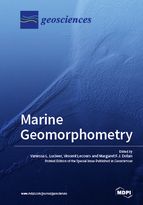Marine Geomorphometry
A special issue of Geosciences (ISSN 2076-3263). This special issue belongs to the section "Geophysics".
Deadline for manuscript submissions: closed (31 October 2017) | Viewed by 175990
Special Issue Editors
Interests: marine remote sensing; acoustic data processing for the seafloor and water column; textural analysis; GEOBIA; biodiversity assessment; bathymetric modelling; backscatter processing and analysis; marine geomorphometry and spatial data modelling
Special Issues, Collections and Topics in MDPI journals
Interests: seabed mapping; multibeam data; terrain analysis; benthic habitat mapping; spatial analysis; geomorphometry
Interests: geomorphometry; GIS; marine habitat mapping; remote sensing; spatial analysis; terrain analysis
Special Issues, Collections and Topics in MDPI journals
Special Issue Information
Dear Colleagues,
Geomorphometry, the science of quantitative terrain analysis, originated in terrestrial investigations; however, many of the methods used in these investigations have also proven applicable in marine environments. The rise in the acquisition of high-resolution seabed data using acoustic systems and bathymetric LiDAR has prompted a growing interest in employing geomorphometric techniques to investigate the seafloor.
The aim of this Special Issue of Geosciences is to showcase quantitative geomorphological analysis techniques for geoscientific research and investigation of the seafloor. We invite contributions addressing all aspects of marine geomorphometry, from data collection and processing to the derivation of terrain attributes/features and their use in an applied context. Relevant topics for this Special Issue include, but are not limited to, new methods for terrain characterization and classification, 3D geomorphometric visualizations, the links between seafloor topography and processes occurring in the surrounding marine environment (water column, sub-surface), and issues related to spatial scale and data quality. We welcome applied studies using marine geomorphometry as part of their workflow (e.g., habitat mapping, geomorphology, geohazards modelling, submarine archaeology). Technical review articles, and submissions reviewing the challenges faced by this thriving field of research are also welcomed.
Dr. Vanessa Lucieer
Dr. Margaret Dolan
Dr. Vincent Lecours
Guest Editors
Manuscript Submission Information
Manuscripts should be submitted online at www.mdpi.com by registering and logging in to this website. Once you are registered, click here to go to the submission form. Manuscripts can be submitted until the deadline. All submissions that pass pre-check are peer-reviewed. Accepted papers will be published continuously in the journal (as soon as accepted) and will be listed together on the special issue website. Research articles, review articles as well as short communications are invited. For planned papers, a title and short abstract (about 100 words) can be sent to the Editorial Office for announcement on this website.
Submitted manuscripts should not have been published previously, nor be under consideration for publication elsewhere (except conference proceedings papers). All manuscripts are thoroughly refereed through a single-blind peer-review process. A guide for authors and other relevant information for submission of manuscripts is available on the Instructions for Authors page. Geosciences is an international peer-reviewed open access monthly journal published by MDPI.
Please visit the Instructions for Authors page before submitting a manuscript. The Article Processing Charge (APC) for publication in this open access journal is 1800 CHF (Swiss Francs). Submitted papers should be well formatted and use good English. Authors may use MDPI's English editing service prior to publication or during author revisions.
Keywords
- GIS
- seabed mapping
- marine geology
- spatial analysis
- marine processes
- spatial scale
- submarine topography
- seafloor remote sensing
- marine geomorphology
- geomorphometry
- terrain analysis
- bathymetry
- structure-from-motion
- multibeam echosounder
- bathymetric lidar
Related Special Issues
- Methods and Applications of High-Resolution Stratigraphy on Continental Margins in Geosciences (6 articles)
- Geological Seafloor Mapping in Geosciences (26 articles)








